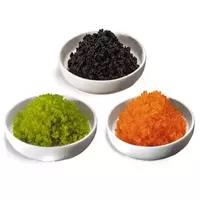Flying fish caviar (tobiko caviar)

Flying fish is a unique species of marine fish, which belongs to the order of Sarganids. Flying fish live in tropical and subtropical warm waters. The main feature of flying fish is its ability to make a continuous planning flight over distances of up to 400 meters. Moreover, the flying fish flies at a car speed of 60 km/h.
In volatile fish, fins and tail are well developed, with which the fish rhythmically hits the water (70 times per second), which allows it to jump out and soar over the water surface. Japan has become a leader in the industrial extraction of flying fish. This is due primarily to the fact that most national Japanese dishes use delicate meat of volatile fish, and more often fish caviar.
Tobiko or flying fish caviar is mainly used in land or rolls. Often, flying fish caviar (Tobiko caviar) is added to Japanese salads, as well as to the first and main dishes as a spectacular decoration. Tobiko is black, green or orange, sometimes you can also find yellow caviar of flying fish. The natural color of flying fish eggs (Tobiko caviar) is light orange.
Tobiko's variety of colors is achieved with the help of natural food dyes. To get the green color of flying fish caviar (Tobiko caviar), chefs add wasabi, ginger is used for rich orange color. Black flying fish caviar (Tobiko caviar) is obtained by mixing sea cuttlefish ink with orange-colored caviar.
Japanese craftsmen have reached the limits of perfection in the more than 500-year history of using flying fish caviar for food. Perhaps therefore, the process of processing and making flying fish caviar has not changed for centuries. Tobiko's flying fish caviar doesn't quite taste our way. Caviar is distinguished by its taste, smell and consumer qualities. Flying fish caviar (Tobiko caviar) crunches on the teeth, it is drier.
It is believed that the best Tobiko caviar is obtained from the Japanese. It is better to purchase caviar of flying fish in canned form, since such a product is already ready for consumption. You can find frozen caviar of flying fish, but before eating such caviar requires preliminary treatment in a special marinade. The benefits of flying fish caviar lie in its chemical composition.
The low calorie content of flying fish caviar in combination with a large amount of natural proteins (up to 30%) in the composition makes this product indispensable for dietary nutrition. The useful properties of flying fish caviar are also in the content of vitamins A, C and D, which help in the prevention and control of many diseases.
Japanese doctors have long used the benefits of flying fish caviar (Tobiko caviar) in the medical nutrition of patients with exhaustion or low blood. It is believed that flying fish caviar is incredibly useful for pregnant women, children, as well as the elderly. Flying fish caviar (Tobiko caviar) is able to maintain the necessary level of nutrients in the body of people who are actively involved in sports or tolerate frequent physical activity.
flying fish caviar (tobiko caviar) 92.13 kCal
Energy value of flying fish caviar (tobiko caviar) (Ratio of proteins, fats, carbohydrates - ju):
Proteins: 13 g (~ 52 kCal)
Fats: 3.1 g (~ 28 kCal)
Carbohydrates: 10g (~ 40kCal)
Energy ratio (bj | y): 56% | 30% | 43%
 Español
Español Français
Français Português
Português Русский
Русский 简体中文
简体中文 繁體中文
繁體中文 日本語
日本語 한국어
한국어 العربية
العربية Türkçe
Türkçe Қазақ
Қазақ Deutsch
Deutsch Italiano
Italiano Українська
Українська
